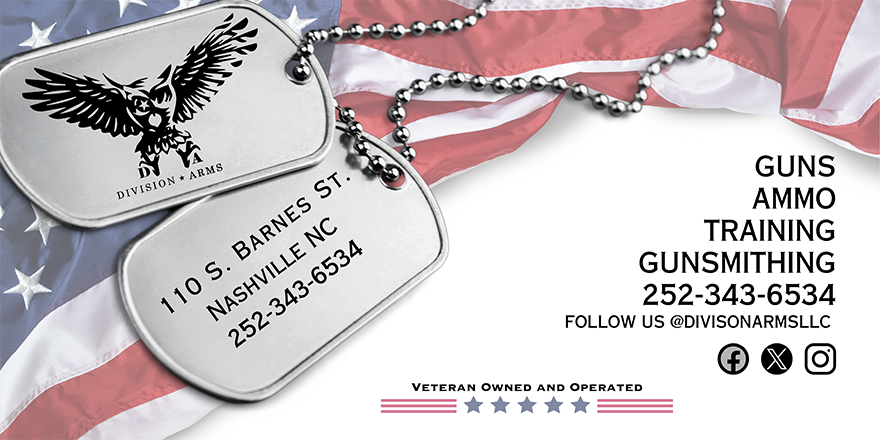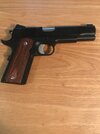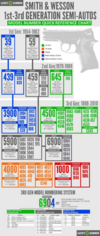It's been a while since I started a technical thread, and I had a little time on my hands this fine evening, so...
But, first a disclaimer. This is for educational purposes only and is in no way a Glock bashing thread, nor is it intended to bolster any arguments for any other design. I don't care for them very much, but my reasons are largely personal and have no place in a purely technical discussion. It's a successful platform. No more needs to be said on that count.
We've also seen the word "Innovation" tossed about a lot when Glocks are the topic. Innovation is defined by Merriam-Webster as the implementation or creation of a new idea or thing.
Okay. So, what about the Glock is innovative? Other than its relatively low cost of production...what is new? What does the Glock have that no pistol before it had?
The short, simple answer is...nothing.
Everything that you see on the Glock has been seen in and on other pistols before. Even the trigger safety was seen on the first generation Iver Johnson break-top "Owl Head" revolvers.
This is not to denigrate Herr Glock's pistol. All designers borrow from others that came before them...even the late, great J. Mose Browning. One only need look closely at a Model 92 or 94 Winchester carbine to see the influence of Christian Sharps' link/lever actuated falling block, and when he gave us the 1885 Winchester High Wall, it was apparent that about the only real difference between that one and the Sharps was the hammer location.
So, about the only innovation is that Gaston's engineers incorporated all those ideas into one pistol along with the use of sheet metal stampings for most of the lockwork in order to hold down the costs.
Let's look at all the things that Gaston borrowed and when and where they first appeared. To keep it simple, I won't go back any further than 1900.
Detachable box magazine and slide/breechblock...Model 1900 Colt.
Locked breech/short recoil operation...1900 Colt.
Frame mounted push-button magazine release...1903 Luger.
Slide lock on empty...Model 1905 Colt.
Striker fired...1903 Luger.
Staged striker...1907 Roth-Steyr.
Tilting barrel locking system...1909. 1910. and 1911 Colt.
Lower barrel lug camming block with frame mounted cross member for engaging and disengaging the barrel from the slide...P-35/High Power.
Integral barrel and feed ramps...P-35/High Power.
"Recoil" spring captive between barrel and slide...P-35/High Power.
Double column staggered round magazine with single feed position...P-35/High Power.
Polymer frame...Heckler & Koch.
So, there's nothing new under the sun and there's really nothing innovative.
Finally...the infamous trigger widget as seen on the aforementioned Owl Head revolver.
Cheers!
JT

But, first a disclaimer. This is for educational purposes only and is in no way a Glock bashing thread, nor is it intended to bolster any arguments for any other design. I don't care for them very much, but my reasons are largely personal and have no place in a purely technical discussion. It's a successful platform. No more needs to be said on that count.
We've also seen the word "Innovation" tossed about a lot when Glocks are the topic. Innovation is defined by Merriam-Webster as the implementation or creation of a new idea or thing.
Okay. So, what about the Glock is innovative? Other than its relatively low cost of production...what is new? What does the Glock have that no pistol before it had?
The short, simple answer is...nothing.
Everything that you see on the Glock has been seen in and on other pistols before. Even the trigger safety was seen on the first generation Iver Johnson break-top "Owl Head" revolvers.
This is not to denigrate Herr Glock's pistol. All designers borrow from others that came before them...even the late, great J. Mose Browning. One only need look closely at a Model 92 or 94 Winchester carbine to see the influence of Christian Sharps' link/lever actuated falling block, and when he gave us the 1885 Winchester High Wall, it was apparent that about the only real difference between that one and the Sharps was the hammer location.
So, about the only innovation is that Gaston's engineers incorporated all those ideas into one pistol along with the use of sheet metal stampings for most of the lockwork in order to hold down the costs.
Let's look at all the things that Gaston borrowed and when and where they first appeared. To keep it simple, I won't go back any further than 1900.
Detachable box magazine and slide/breechblock...Model 1900 Colt.
Locked breech/short recoil operation...1900 Colt.
Frame mounted push-button magazine release...1903 Luger.
Slide lock on empty...Model 1905 Colt.
Striker fired...1903 Luger.
Staged striker...1907 Roth-Steyr.
Tilting barrel locking system...1909. 1910. and 1911 Colt.
Lower barrel lug camming block with frame mounted cross member for engaging and disengaging the barrel from the slide...P-35/High Power.
Integral barrel and feed ramps...P-35/High Power.
"Recoil" spring captive between barrel and slide...P-35/High Power.
Double column staggered round magazine with single feed position...P-35/High Power.
Polymer frame...Heckler & Koch.
So, there's nothing new under the sun and there's really nothing innovative.
Finally...the infamous trigger widget as seen on the aforementioned Owl Head revolver.
Cheers!
JT

Last edited:





